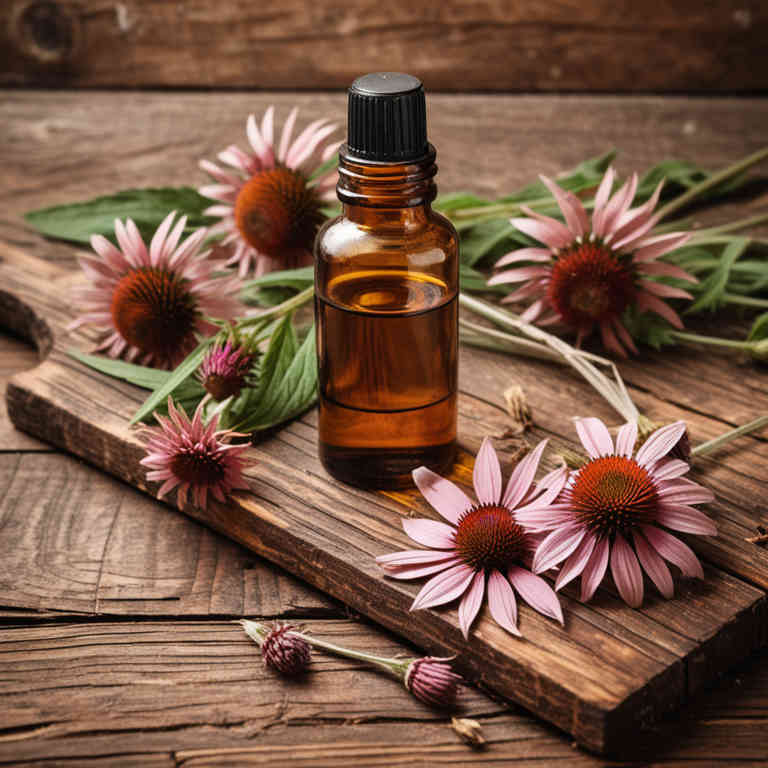Echinacea angustifolia essential oil for medicinal use

Echinacea angustifolia essential oil is a concentrated aromatic extract derived from the roots and flowers of the echinacea plant, known for its immune-boosting properties.
It is traditionally used in herbalism to support the body's natural defenses and may help alleviate symptoms of colds and respiratory infections. The oil is often diluted with a carrier oil before application to the skin, where it is believed to have anti-inflammatory and antimicrobial effects. It is also used in aromatherapy to promote respiratory health and reduce stress.
Due to its potency, it should be used cautiously and under the guidance of a qualified herbalist.
Uses
Echinacea angustifolia essential oil has been used to support immune function and treat respiratory infections for centuries, particularly by Indigenous peoples of North America.
Traditionally, it was incorporated into teas, salves, and poultices to alleviate symptoms of colds, flu, and skin conditions. In modern times, it is widely used as a natural remedy for boosting immunity and reducing the duration of viral infections. Scientific studies suggest it may have anti-inflammatory and antimicrobial properties.
However, its efficacy and safety continue to be the subject of ongoing research and debate in the medical community.
Benefits
Echinacea angustifolia essential oil has health benefits such as boosting the immune system, reducing inflammation, and supporting respiratory health.
It is commonly used to help alleviate symptoms of colds, flu, and other respiratory infections. The oil contains compounds like alkamides, caffeic acid derivatives, and flavonoids, which contribute to its antimicrobial and anti-inflammatory properties. It may also aid in reducing the duration and severity of illnesses when used as part of a holistic approach to wellness.
However, it is important to consult a healthcare professional before use, especially for those with allergies or chronic conditions.
Constituents
Echinacea angustifolia essential oil active constituents include alkamides, caffeic acid derivatives, and polysaccharides, which contribute to its therapeutic properties.
These compounds are known to enhance immune function by stimulating the production of white blood cells and modulating inflammatory responses. Alkamides, in particular, are believed to interact with the body’s immune system to provide antimicrobial and anti-inflammatory benefits. Caffeic acid derivatives exhibit antioxidant and antiviral activities, supporting overall health and wellness.
Polysaccharides further support immune health by promoting the activity of macrophages and other immune cells.
Preparation
To make Echinacea angustifolia essential oil, first gather fresh or dried Echinacea angustifolia plant material, preferably the flowers and leaves.
Next, place the plant material in a glass jar and cover it completely with a high-quality carrier oil such as jojoba or almond oil. Allow the mixture to infuse for 4 to 6 weeks in a cool, dark place, shaking the jar gently every few days. After the infusion period, strain the oil through a fine mesh or cheesecloth to remove the plant material.
Finally, store the essential oil in a dark glass bottle away from light and heat to preserve its potency.
Side Effects
Echinacea angustifolia essential oil may lead to gastrointestinal discomfort, including nausea, vomiting, and diarrhea, in some individuals.
It can also cause allergic reactions, particularly in people with a history of allergies to plants in the Asteraceae family, such as ragweed. The oil may interact with certain medications, potentially reducing their effectiveness or increasing the risk of side effects. Long-term use might lead to skin irritation or sensitization when applied topically.
It is important to consult a healthcare professional before using this essential oil, especially for those with existing health conditions or who are taking other medications.